(B124 EMA)Prepare the income statement for Ayla King
VerifiedAdded on 2023/05/03
|10
|2634
|364
Assignment
AI Summary
In this assignment report we will discuss about income statement below are the summaries point:-
Financial information should be appropriate for comparison between different accounting periods.
Similar accounting practices/policies should be used consistently.
E.g. using different inventory valuation methods (LIFO vs FIFO) can lead to changes in financial performance analysis over time.
Financial information should be presented clearly and be easily understandable.
Complex financial statements can undermine the reliability of financial statements.
E.g. Enron Corporation had complex financial statements that were not understandable, leading to its collapse.
The accounting equation (Assets = Liabilities + Equity) forms the basis for the balance sheet and income statement.
Income statement links to balance sheet (and vice versa) through various aspects such as depreciation on assets, net profit, and inventory.
Profit impacts the accounting equation by affecting assets, liabilities, and equity.
Contribute Materials
Your contribution can guide someone’s learning journey. Share your
documents today.
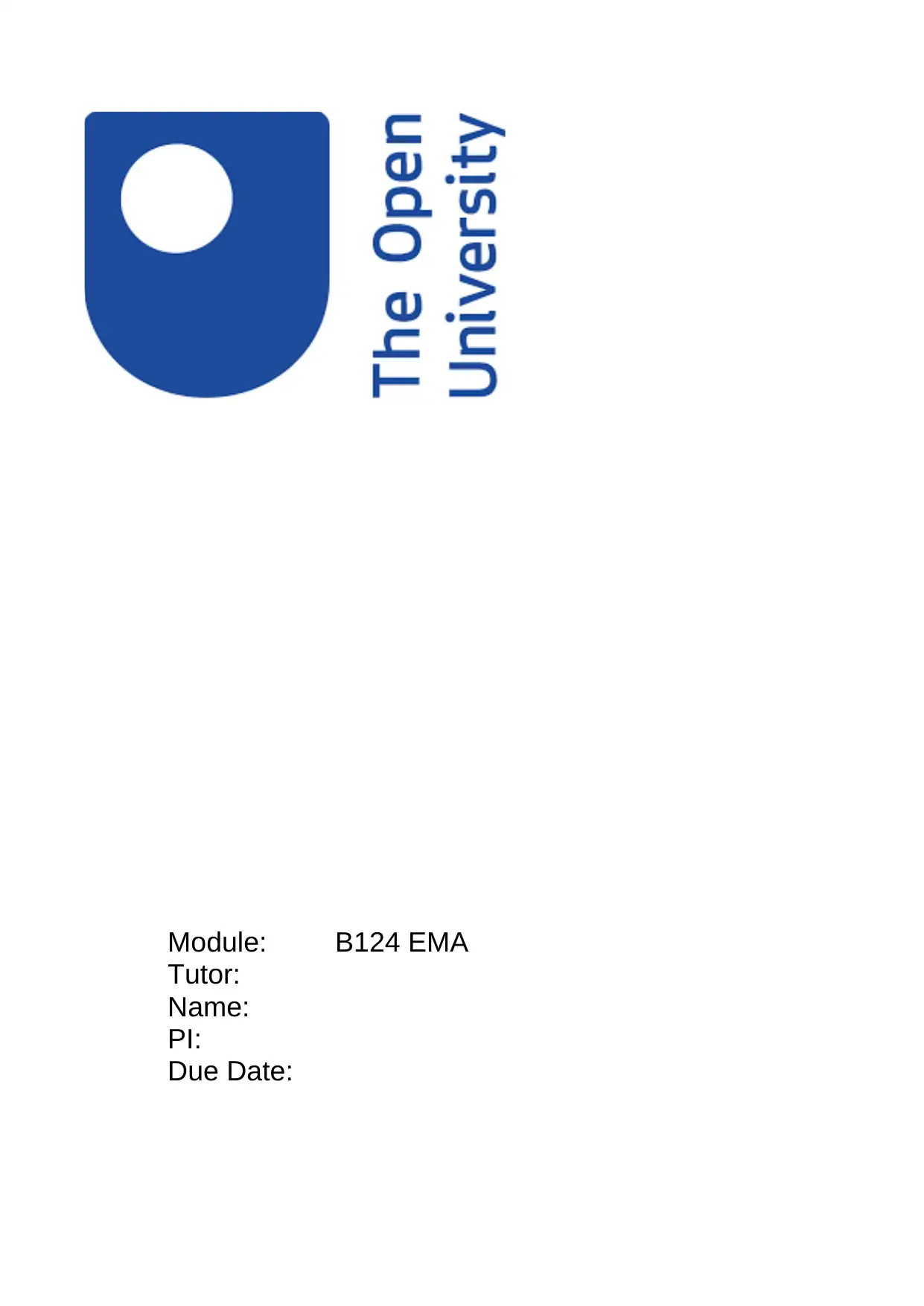
Module: B124 EMA
Tutor:
Name:
PI:
Due Date:
Tutor:
Name:
PI:
Due Date:
Secure Best Marks with AI Grader
Need help grading? Try our AI Grader for instant feedback on your assignments.
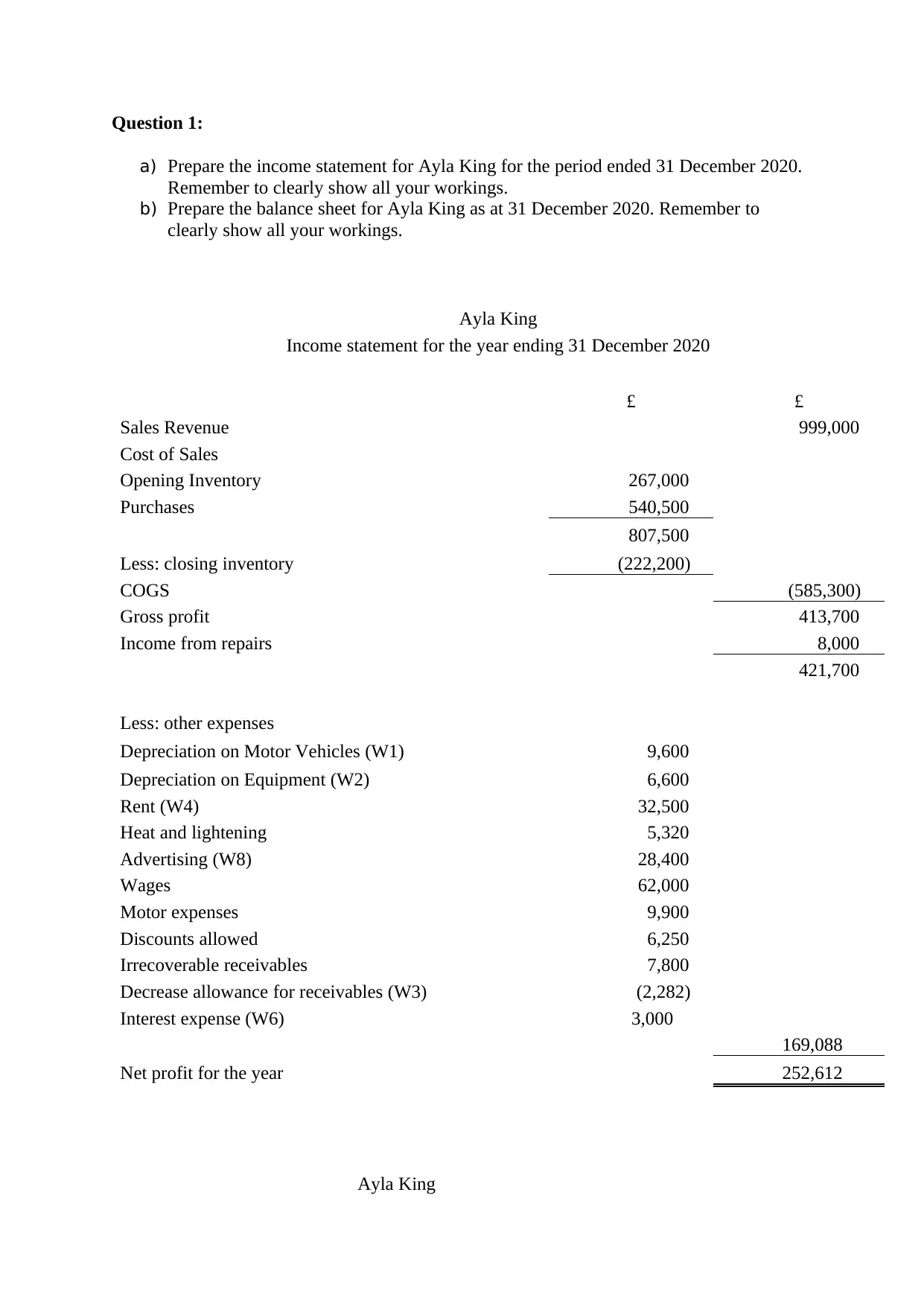
Question 1:
a) Prepare the income statement for Ayla King for the period ended 31 December 2020.
Remember to clearly show all your workings.
b) Prepare the balance sheet for Ayla King as at 31 December 2020. Remember to
clearly show all your workings.
Ayla King
Income statement for the year ending 31 December 2020
£ £
Sales Revenue 999,000
Cost of Sales
Opening Inventory 267,000
Purchases 540,500
807,500
Less: closing inventory (222,200)
COGS (585,300)
Gross profit 413,700
Income from repairs 8,000
421,700
Less: other expenses
Depreciation on Motor Vehicles (W1) 9,600
Depreciation on Equipment (W2) 6,600
Rent (W4) 32,500
Heat and lightening 5,320
Advertising (W8) 28,400
Wages 62,000
Motor expenses 9,900
Discounts allowed 6,250
Irrecoverable receivables 7,800
Decrease allowance for receivables (W3) (2,282)
Interest expense (W6) 3,000
169,088
Net profit for the year 252,612
Ayla King
a) Prepare the income statement for Ayla King for the period ended 31 December 2020.
Remember to clearly show all your workings.
b) Prepare the balance sheet for Ayla King as at 31 December 2020. Remember to
clearly show all your workings.
Ayla King
Income statement for the year ending 31 December 2020
£ £
Sales Revenue 999,000
Cost of Sales
Opening Inventory 267,000
Purchases 540,500
807,500
Less: closing inventory (222,200)
COGS (585,300)
Gross profit 413,700
Income from repairs 8,000
421,700
Less: other expenses
Depreciation on Motor Vehicles (W1) 9,600
Depreciation on Equipment (W2) 6,600
Rent (W4) 32,500
Heat and lightening 5,320
Advertising (W8) 28,400
Wages 62,000
Motor expenses 9,900
Discounts allowed 6,250
Irrecoverable receivables 7,800
Decrease allowance for receivables (W3) (2,282)
Interest expense (W6) 3,000
169,088
Net profit for the year 252,612
Ayla King
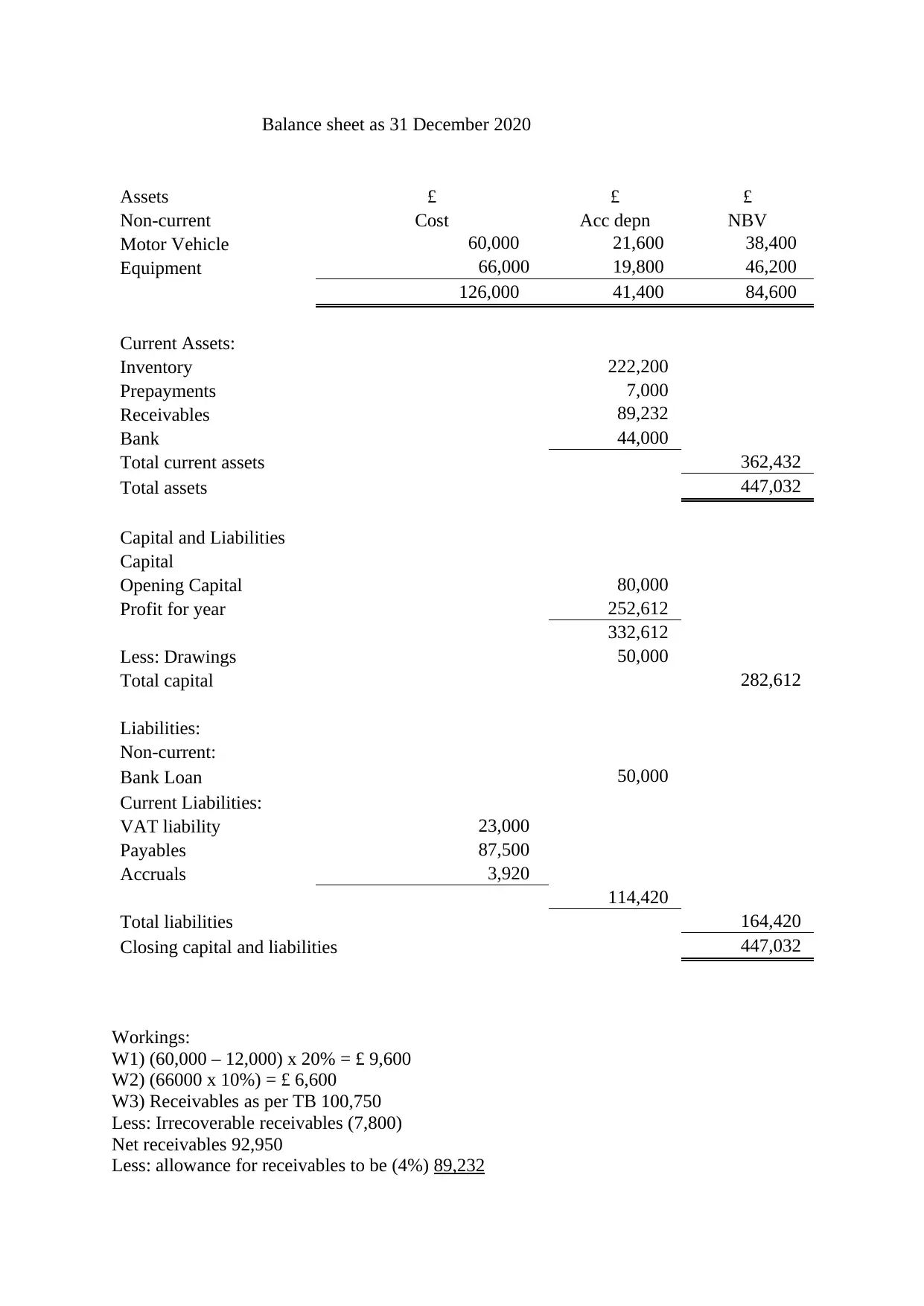
Balance sheet as 31 December 2020
Assets £ £ £
Non-current Cost Acc depn NBV
Motor Vehicle 60,000 21,600 38,400
Equipment 66,000 19,800 46,200
126,000 41,400 84,600
Current Assets:
Inventory 222,200
Prepayments 7,000
Receivables 89,232
Bank 44,000
Total current assets 362,432
Total assets 447,032
Capital and Liabilities
Capital
Opening Capital 80,000
Profit for year 252,612
332,612
Less: Drawings 50,000
Total capital 282,612
Liabilities:
Non-current:
Bank Loan 50,000
Current Liabilities:
VAT liability 23,000
Payables 87,500
Accruals 3,920
114,420
Total liabilities 164,420
Closing capital and liabilities 447,032
Workings:
W1) (60,000 – 12,000) x 20% = £ 9,600
W2) (66000 x 10%) = £ 6,600
W3) Receivables as per TB 100,750
Less: Irrecoverable receivables (7,800)
Net receivables 92,950
Less: allowance for receivables to be (4%) 89,232
Assets £ £ £
Non-current Cost Acc depn NBV
Motor Vehicle 60,000 21,600 38,400
Equipment 66,000 19,800 46,200
126,000 41,400 84,600
Current Assets:
Inventory 222,200
Prepayments 7,000
Receivables 89,232
Bank 44,000
Total current assets 362,432
Total assets 447,032
Capital and Liabilities
Capital
Opening Capital 80,000
Profit for year 252,612
332,612
Less: Drawings 50,000
Total capital 282,612
Liabilities:
Non-current:
Bank Loan 50,000
Current Liabilities:
VAT liability 23,000
Payables 87,500
Accruals 3,920
114,420
Total liabilities 164,420
Closing capital and liabilities 447,032
Workings:
W1) (60,000 – 12,000) x 20% = £ 9,600
W2) (66000 x 10%) = £ 6,600
W3) Receivables as per TB 100,750
Less: Irrecoverable receivables (7,800)
Net receivables 92,950
Less: allowance for receivables to be (4%) 89,232
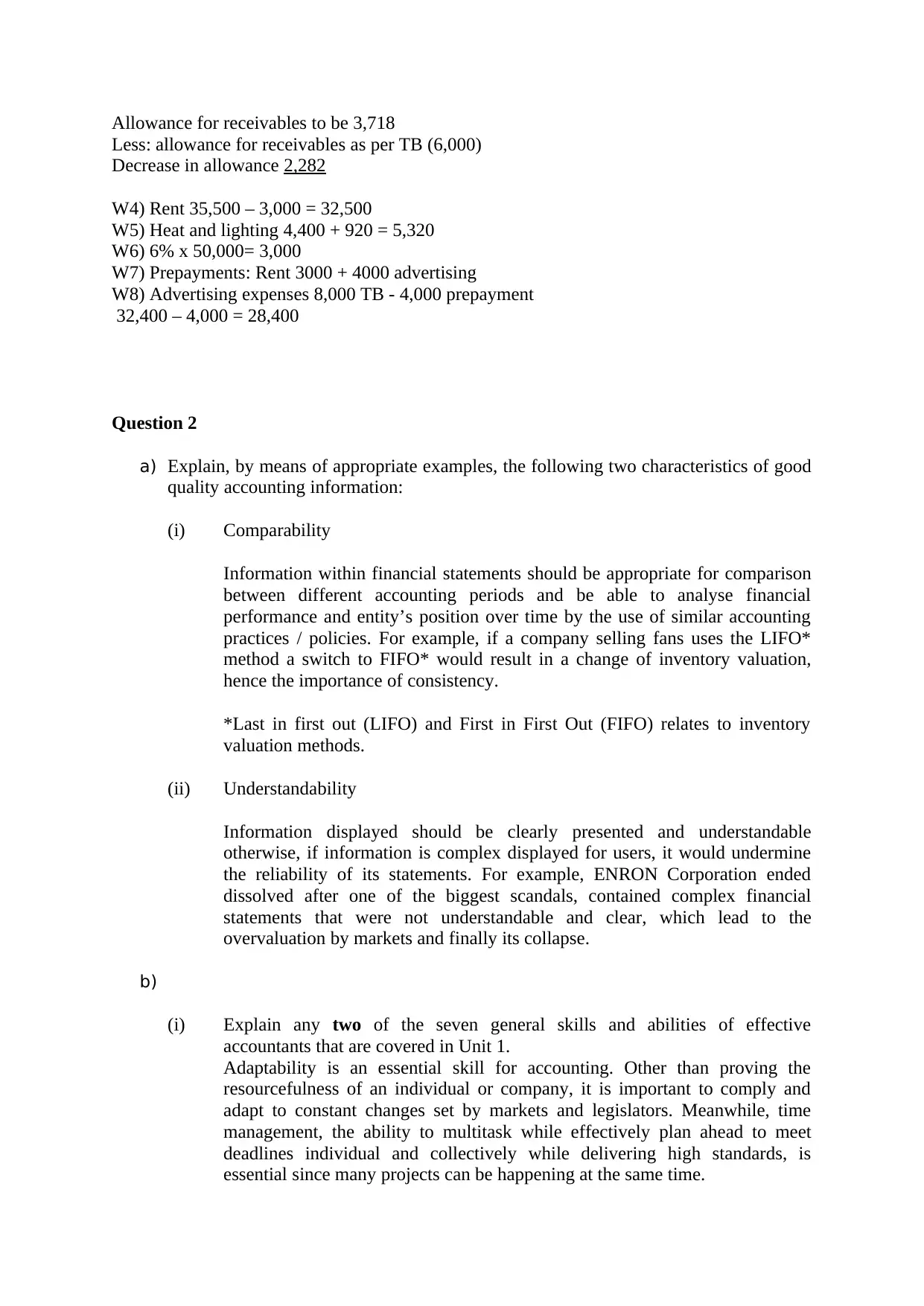
Allowance for receivables to be 3,718
Less: allowance for receivables as per TB (6,000)
Decrease in allowance 2,282
W4) Rent 35,500 – 3,000 = 32,500
W5) Heat and lighting 4,400 + 920 = 5,320
W6) 6% x 50,000= 3,000
W7) Prepayments: Rent 3000 + 4000 advertising
W8) Advertising expenses 8,000 TB - 4,000 prepayment
32,400 – 4,000 = 28,400
Question 2
a) Explain, by means of appropriate examples, the following two characteristics of good
quality accounting information:
(i) Comparability
Information within financial statements should be appropriate for comparison
between different accounting periods and be able to analyse financial
performance and entity’s position over time by the use of similar accounting
practices / policies. For example, if a company selling fans uses the LIFO*
method a switch to FIFO* would result in a change of inventory valuation,
hence the importance of consistency.
*Last in first out (LIFO) and First in First Out (FIFO) relates to inventory
valuation methods.
(ii) Understandability
Information displayed should be clearly presented and understandable
otherwise, if information is complex displayed for users, it would undermine
the reliability of its statements. For example, ENRON Corporation ended
dissolved after one of the biggest scandals, contained complex financial
statements that were not understandable and clear, which lead to the
overvaluation by markets and finally its collapse.
b)
(i) Explain any two of the seven general skills and abilities of effective
accountants that are covered in Unit 1.
Adaptability is an essential skill for accounting. Other than proving the
resourcefulness of an individual or company, it is important to comply and
adapt to constant changes set by markets and legislators. Meanwhile, time
management, the ability to multitask while effectively plan ahead to meet
deadlines individual and collectively while delivering high standards, is
essential since many projects can be happening at the same time.
Less: allowance for receivables as per TB (6,000)
Decrease in allowance 2,282
W4) Rent 35,500 – 3,000 = 32,500
W5) Heat and lighting 4,400 + 920 = 5,320
W6) 6% x 50,000= 3,000
W7) Prepayments: Rent 3000 + 4000 advertising
W8) Advertising expenses 8,000 TB - 4,000 prepayment
32,400 – 4,000 = 28,400
Question 2
a) Explain, by means of appropriate examples, the following two characteristics of good
quality accounting information:
(i) Comparability
Information within financial statements should be appropriate for comparison
between different accounting periods and be able to analyse financial
performance and entity’s position over time by the use of similar accounting
practices / policies. For example, if a company selling fans uses the LIFO*
method a switch to FIFO* would result in a change of inventory valuation,
hence the importance of consistency.
*Last in first out (LIFO) and First in First Out (FIFO) relates to inventory
valuation methods.
(ii) Understandability
Information displayed should be clearly presented and understandable
otherwise, if information is complex displayed for users, it would undermine
the reliability of its statements. For example, ENRON Corporation ended
dissolved after one of the biggest scandals, contained complex financial
statements that were not understandable and clear, which lead to the
overvaluation by markets and finally its collapse.
b)
(i) Explain any two of the seven general skills and abilities of effective
accountants that are covered in Unit 1.
Adaptability is an essential skill for accounting. Other than proving the
resourcefulness of an individual or company, it is important to comply and
adapt to constant changes set by markets and legislators. Meanwhile, time
management, the ability to multitask while effectively plan ahead to meet
deadlines individual and collectively while delivering high standards, is
essential since many projects can be happening at the same time.
Secure Best Marks with AI Grader
Need help grading? Try our AI Grader for instant feedback on your assignments.
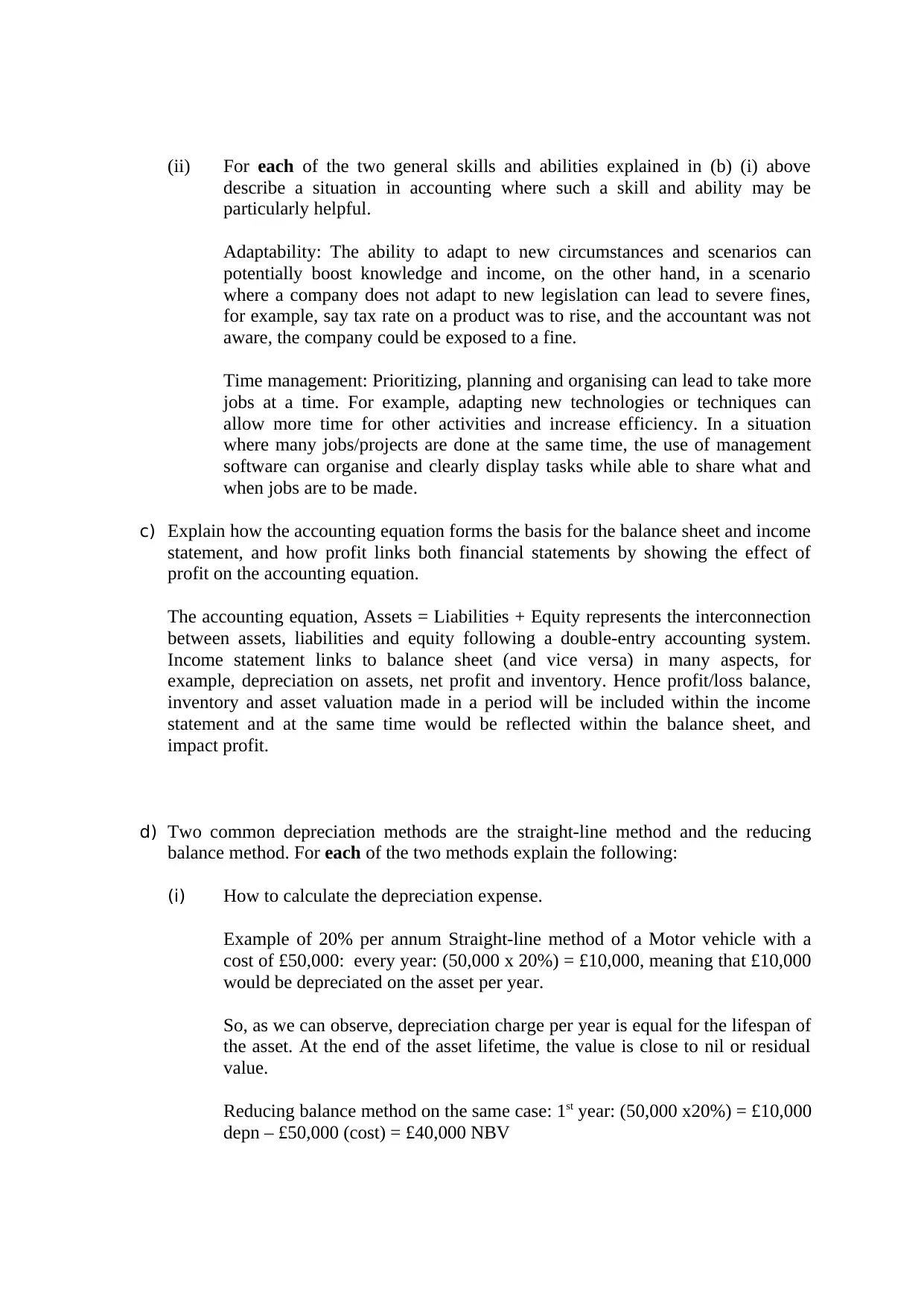
(ii) For each of the two general skills and abilities explained in (b) (i) above
describe a situation in accounting where such a skill and ability may be
particularly helpful.
Adaptability: The ability to adapt to new circumstances and scenarios can
potentially boost knowledge and income, on the other hand, in a scenario
where a company does not adapt to new legislation can lead to severe fines,
for example, say tax rate on a product was to rise, and the accountant was not
aware, the company could be exposed to a fine.
Time management: Prioritizing, planning and organising can lead to take more
jobs at a time. For example, adapting new technologies or techniques can
allow more time for other activities and increase efficiency. In a situation
where many jobs/projects are done at the same time, the use of management
software can organise and clearly display tasks while able to share what and
when jobs are to be made.
c) Explain how the accounting equation forms the basis for the balance sheet and income
statement, and how profit links both financial statements by showing the effect of
profit on the accounting equation.
The accounting equation, Assets = Liabilities + Equity represents the interconnection
between assets, liabilities and equity following a double-entry accounting system.
Income statement links to balance sheet (and vice versa) in many aspects, for
example, depreciation on assets, net profit and inventory. Hence profit/loss balance,
inventory and asset valuation made in a period will be included within the income
statement and at the same time would be reflected within the balance sheet, and
impact profit.
d) Two common depreciation methods are the straight-line method and the reducing
balance method. For each of the two methods explain the following:
(i) How to calculate the depreciation expense.
Example of 20% per annum Straight-line method of a Motor vehicle with a
cost of £50,000: every year: (50,000 x 20%) = £10,000, meaning that £10,000
would be depreciated on the asset per year.
So, as we can observe, depreciation charge per year is equal for the lifespan of
the asset. At the end of the asset lifetime, the value is close to nil or residual
value.
Reducing balance method on the same case: 1st year: (50,000 x20%) = £10,000
depn – £50,000 (cost) = £40,000 NBV
describe a situation in accounting where such a skill and ability may be
particularly helpful.
Adaptability: The ability to adapt to new circumstances and scenarios can
potentially boost knowledge and income, on the other hand, in a scenario
where a company does not adapt to new legislation can lead to severe fines,
for example, say tax rate on a product was to rise, and the accountant was not
aware, the company could be exposed to a fine.
Time management: Prioritizing, planning and organising can lead to take more
jobs at a time. For example, adapting new technologies or techniques can
allow more time for other activities and increase efficiency. In a situation
where many jobs/projects are done at the same time, the use of management
software can organise and clearly display tasks while able to share what and
when jobs are to be made.
c) Explain how the accounting equation forms the basis for the balance sheet and income
statement, and how profit links both financial statements by showing the effect of
profit on the accounting equation.
The accounting equation, Assets = Liabilities + Equity represents the interconnection
between assets, liabilities and equity following a double-entry accounting system.
Income statement links to balance sheet (and vice versa) in many aspects, for
example, depreciation on assets, net profit and inventory. Hence profit/loss balance,
inventory and asset valuation made in a period will be included within the income
statement and at the same time would be reflected within the balance sheet, and
impact profit.
d) Two common depreciation methods are the straight-line method and the reducing
balance method. For each of the two methods explain the following:
(i) How to calculate the depreciation expense.
Example of 20% per annum Straight-line method of a Motor vehicle with a
cost of £50,000: every year: (50,000 x 20%) = £10,000, meaning that £10,000
would be depreciated on the asset per year.
So, as we can observe, depreciation charge per year is equal for the lifespan of
the asset. At the end of the asset lifetime, the value is close to nil or residual
value.
Reducing balance method on the same case: 1st year: (50,000 x20%) = £10,000
depn – £50,000 (cost) = £40,000 NBV
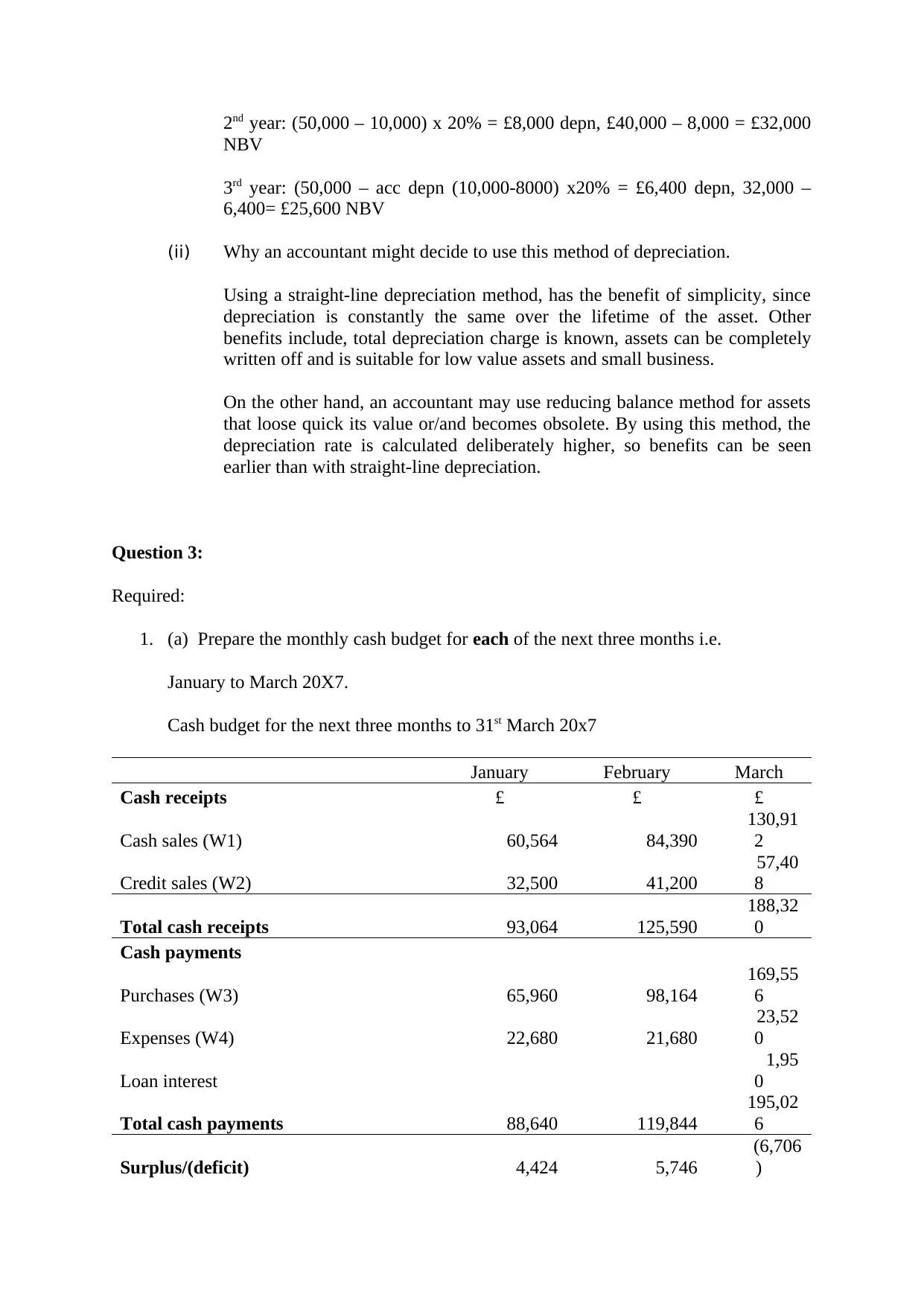
2nd year: (50,000 – 10,000) x 20% = £8,000 depn, £40,000 – 8,000 = £32,000
NBV
3rd year: (50,000 – acc depn (10,000-8000) x20% = £6,400 depn, 32,000 –
6,400= £25,600 NBV
(ii) Why an accountant might decide to use this method of depreciation.
Using a straight-line depreciation method, has the benefit of simplicity, since
depreciation is constantly the same over the lifetime of the asset. Other
benefits include, total depreciation charge is known, assets can be completely
written off and is suitable for low value assets and small business.
On the other hand, an accountant may use reducing balance method for assets
that loose quick its value or/and becomes obsolete. By using this method, the
depreciation rate is calculated deliberately higher, so benefits can be seen
earlier than with straight-line depreciation.
Question 3:
Required:
1. (a) Prepare the monthly cash budget for each of the next three months i.e.
January to March 20X7.
Cash budget for the next three months to 31st March 20x7
January February March
Cash receipts £ £ £
Cash sales (W1) 60,564 84,390
130,91
2
Credit sales (W2) 32,500 41,200
57,40
8
Total cash receipts 93,064 125,590
188,32
0
Cash payments
Purchases (W3) 65,960 98,164
169,55
6
Expenses (W4) 22,680 21,680
23,52
0
Loan interest
1,95
0
Total cash payments 88,640 119,844
195,02
6
Surplus/(deficit) 4,424 5,746
(6,706
)
NBV
3rd year: (50,000 – acc depn (10,000-8000) x20% = £6,400 depn, 32,000 –
6,400= £25,600 NBV
(ii) Why an accountant might decide to use this method of depreciation.
Using a straight-line depreciation method, has the benefit of simplicity, since
depreciation is constantly the same over the lifetime of the asset. Other
benefits include, total depreciation charge is known, assets can be completely
written off and is suitable for low value assets and small business.
On the other hand, an accountant may use reducing balance method for assets
that loose quick its value or/and becomes obsolete. By using this method, the
depreciation rate is calculated deliberately higher, so benefits can be seen
earlier than with straight-line depreciation.
Question 3:
Required:
1. (a) Prepare the monthly cash budget for each of the next three months i.e.
January to March 20X7.
Cash budget for the next three months to 31st March 20x7
January February March
Cash receipts £ £ £
Cash sales (W1) 60,564 84,390
130,91
2
Credit sales (W2) 32,500 41,200
57,40
8
Total cash receipts 93,064 125,590
188,32
0
Cash payments
Purchases (W3) 65,960 98,164
169,55
6
Expenses (W4) 22,680 21,680
23,52
0
Loan interest
1,95
0
Total cash payments 88,640 119,844
195,02
6
Surplus/(deficit) 4,424 5,746
(6,706
)
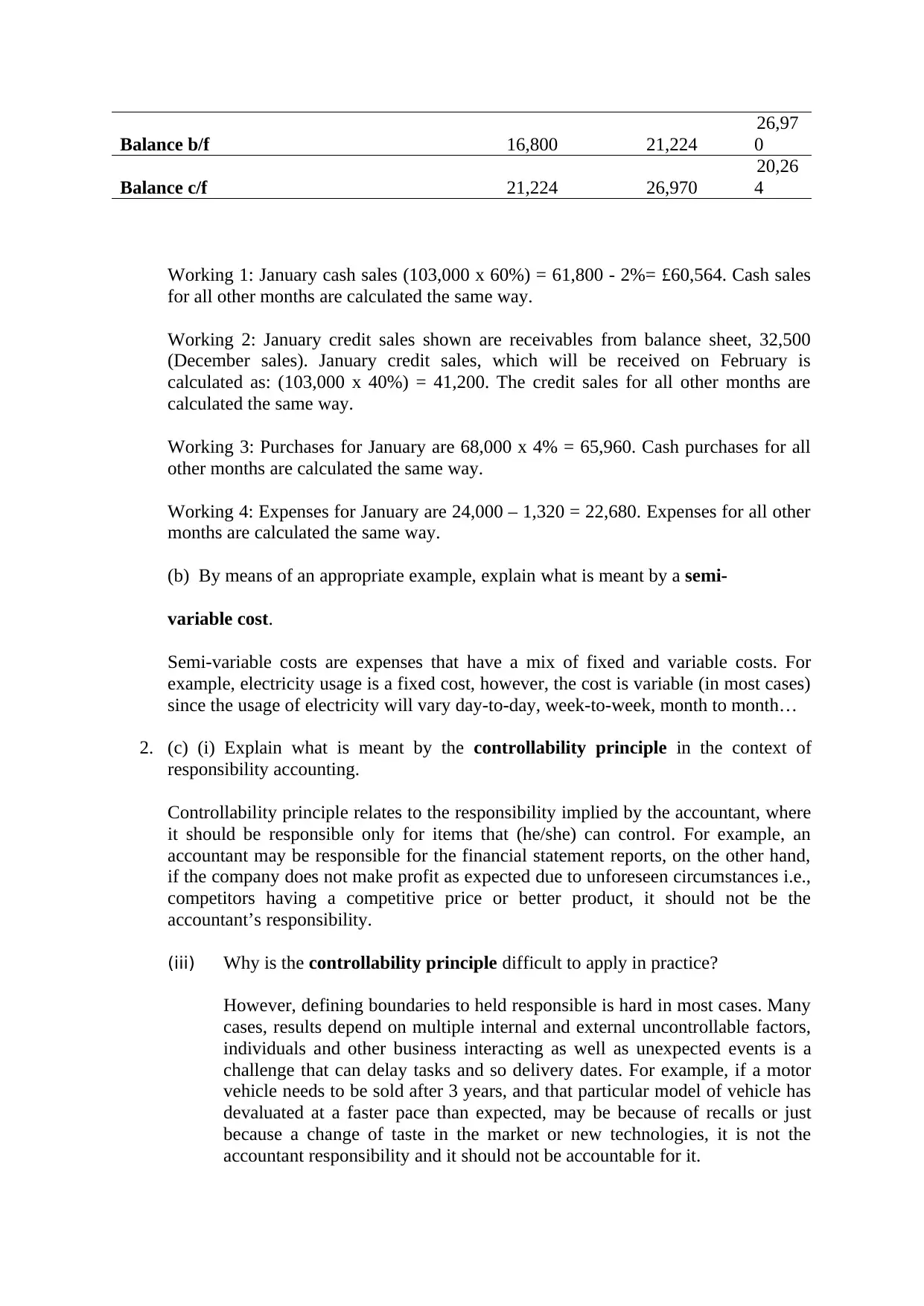
Balance b/f 16,800 21,224
26,97
0
Balance c/f 21,224 26,970
20,26
4
Working 1: January cash sales (103,000 x 60%) = 61,800 - 2%= £60,564. Cash sales
for all other months are calculated the same way.
Working 2: January credit sales shown are receivables from balance sheet, 32,500
(December sales). January credit sales, which will be received on February is
calculated as: (103,000 x 40%) = 41,200. The credit sales for all other months are
calculated the same way.
Working 3: Purchases for January are 68,000 x 4% = 65,960. Cash purchases for all
other months are calculated the same way.
Working 4: Expenses for January are 24,000 – 1,320 = 22,680. Expenses for all other
months are calculated the same way.
(b) By means of an appropriate example, explain what is meant by a semi-
variable cost.
Semi-variable costs are expenses that have a mix of fixed and variable costs. For
example, electricity usage is a fixed cost, however, the cost is variable (in most cases)
since the usage of electricity will vary day-to-day, week-to-week, month to month…
2. (c) (i) Explain what is meant by the controllability principle in the context of
responsibility accounting.
Controllability principle relates to the responsibility implied by the accountant, where
it should be responsible only for items that (he/she) can control. For example, an
accountant may be responsible for the financial statement reports, on the other hand,
if the company does not make profit as expected due to unforeseen circumstances i.e.,
competitors having a competitive price or better product, it should not be the
accountant’s responsibility.
(iii) Why is the controllability principle difficult to apply in practice?
However, defining boundaries to held responsible is hard in most cases. Many
cases, results depend on multiple internal and external uncontrollable factors,
individuals and other business interacting as well as unexpected events is a
challenge that can delay tasks and so delivery dates. For example, if a motor
vehicle needs to be sold after 3 years, and that particular model of vehicle has
devaluated at a faster pace than expected, may be because of recalls or just
because a change of taste in the market or new technologies, it is not the
accountant responsibility and it should not be accountable for it.
26,97
0
Balance c/f 21,224 26,970
20,26
4
Working 1: January cash sales (103,000 x 60%) = 61,800 - 2%= £60,564. Cash sales
for all other months are calculated the same way.
Working 2: January credit sales shown are receivables from balance sheet, 32,500
(December sales). January credit sales, which will be received on February is
calculated as: (103,000 x 40%) = 41,200. The credit sales for all other months are
calculated the same way.
Working 3: Purchases for January are 68,000 x 4% = 65,960. Cash purchases for all
other months are calculated the same way.
Working 4: Expenses for January are 24,000 – 1,320 = 22,680. Expenses for all other
months are calculated the same way.
(b) By means of an appropriate example, explain what is meant by a semi-
variable cost.
Semi-variable costs are expenses that have a mix of fixed and variable costs. For
example, electricity usage is a fixed cost, however, the cost is variable (in most cases)
since the usage of electricity will vary day-to-day, week-to-week, month to month…
2. (c) (i) Explain what is meant by the controllability principle in the context of
responsibility accounting.
Controllability principle relates to the responsibility implied by the accountant, where
it should be responsible only for items that (he/she) can control. For example, an
accountant may be responsible for the financial statement reports, on the other hand,
if the company does not make profit as expected due to unforeseen circumstances i.e.,
competitors having a competitive price or better product, it should not be the
accountant’s responsibility.
(iii) Why is the controllability principle difficult to apply in practice?
However, defining boundaries to held responsible is hard in most cases. Many
cases, results depend on multiple internal and external uncontrollable factors,
individuals and other business interacting as well as unexpected events is a
challenge that can delay tasks and so delivery dates. For example, if a motor
vehicle needs to be sold after 3 years, and that particular model of vehicle has
devaluated at a faster pace than expected, may be because of recalls or just
because a change of taste in the market or new technologies, it is not the
accountant responsibility and it should not be accountable for it.
Paraphrase This Document
Need a fresh take? Get an instant paraphrase of this document with our AI Paraphraser
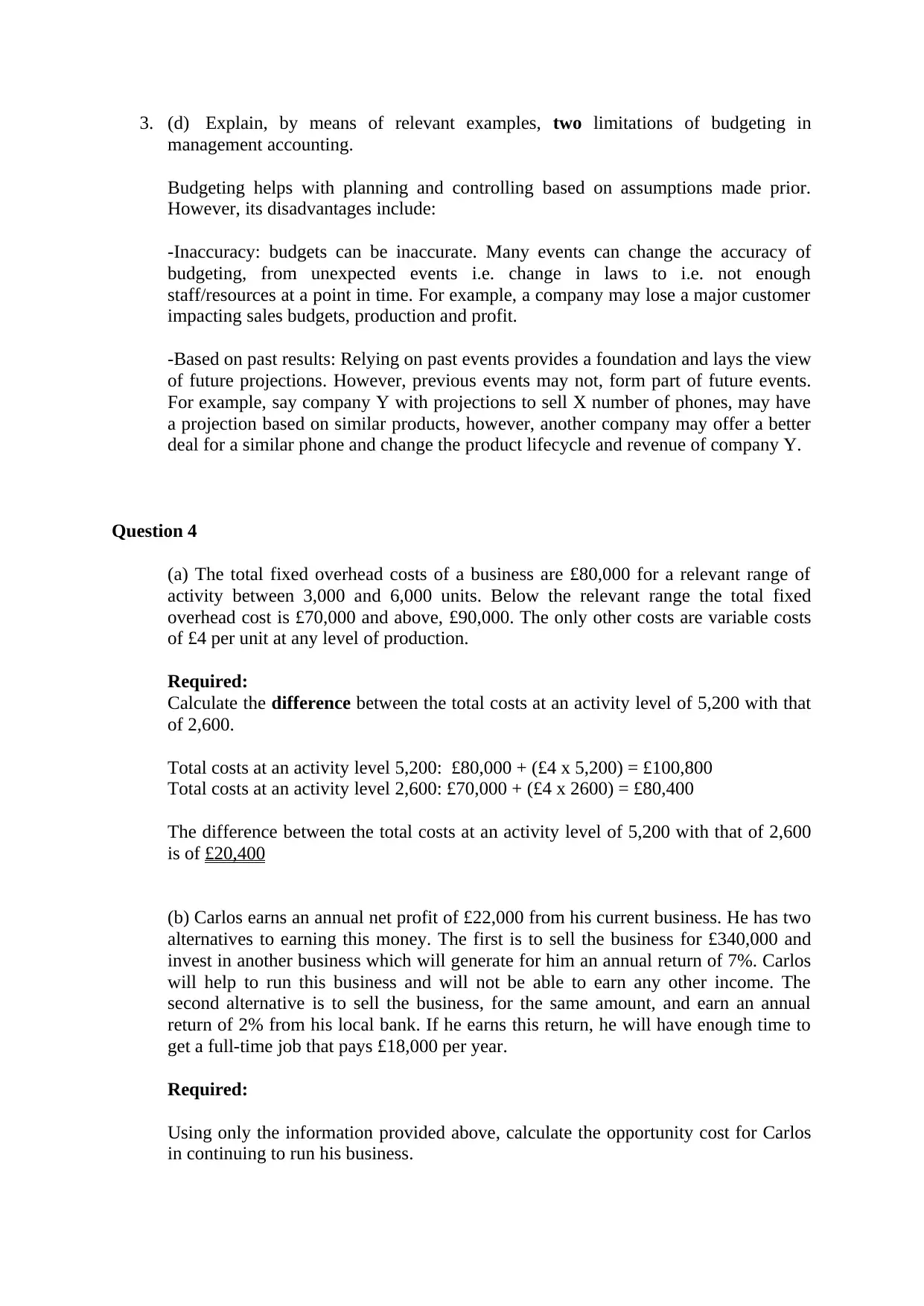
3. (d) Explain, by means of relevant examples, two limitations of budgeting in
management accounting.
Budgeting helps with planning and controlling based on assumptions made prior.
However, its disadvantages include:
-Inaccuracy: budgets can be inaccurate. Many events can change the accuracy of
budgeting, from unexpected events i.e. change in laws to i.e. not enough
staff/resources at a point in time. For example, a company may lose a major customer
impacting sales budgets, production and profit.
-Based on past results: Relying on past events provides a foundation and lays the view
of future projections. However, previous events may not, form part of future events.
For example, say company Y with projections to sell X number of phones, may have
a projection based on similar products, however, another company may offer a better
deal for a similar phone and change the product lifecycle and revenue of company Y.
Question 4
(a) The total fixed overhead costs of a business are £80,000 for a relevant range of
activity between 3,000 and 6,000 units. Below the relevant range the total fixed
overhead cost is £70,000 and above, £90,000. The only other costs are variable costs
of £4 per unit at any level of production.
Required:
Calculate the difference between the total costs at an activity level of 5,200 with that
of 2,600.
Total costs at an activity level 5,200: £80,000 + (£4 x 5,200) = £100,800
Total costs at an activity level 2,600: £70,000 + (£4 x 2600) = £80,400
The difference between the total costs at an activity level of 5,200 with that of 2,600
is of £20,400
(b) Carlos earns an annual net profit of £22,000 from his current business. He has two
alternatives to earning this money. The first is to sell the business for £340,000 and
invest in another business which will generate for him an annual return of 7%. Carlos
will help to run this business and will not be able to earn any other income. The
second alternative is to sell the business, for the same amount, and earn an annual
return of 2% from his local bank. If he earns this return, he will have enough time to
get a full-time job that pays £18,000 per year.
Required:
Using only the information provided above, calculate the opportunity cost for Carlos
in continuing to run his business.
management accounting.
Budgeting helps with planning and controlling based on assumptions made prior.
However, its disadvantages include:
-Inaccuracy: budgets can be inaccurate. Many events can change the accuracy of
budgeting, from unexpected events i.e. change in laws to i.e. not enough
staff/resources at a point in time. For example, a company may lose a major customer
impacting sales budgets, production and profit.
-Based on past results: Relying on past events provides a foundation and lays the view
of future projections. However, previous events may not, form part of future events.
For example, say company Y with projections to sell X number of phones, may have
a projection based on similar products, however, another company may offer a better
deal for a similar phone and change the product lifecycle and revenue of company Y.
Question 4
(a) The total fixed overhead costs of a business are £80,000 for a relevant range of
activity between 3,000 and 6,000 units. Below the relevant range the total fixed
overhead cost is £70,000 and above, £90,000. The only other costs are variable costs
of £4 per unit at any level of production.
Required:
Calculate the difference between the total costs at an activity level of 5,200 with that
of 2,600.
Total costs at an activity level 5,200: £80,000 + (£4 x 5,200) = £100,800
Total costs at an activity level 2,600: £70,000 + (£4 x 2600) = £80,400
The difference between the total costs at an activity level of 5,200 with that of 2,600
is of £20,400
(b) Carlos earns an annual net profit of £22,000 from his current business. He has two
alternatives to earning this money. The first is to sell the business for £340,000 and
invest in another business which will generate for him an annual return of 7%. Carlos
will help to run this business and will not be able to earn any other income. The
second alternative is to sell the business, for the same amount, and earn an annual
return of 2% from his local bank. If he earns this return, he will have enough time to
get a full-time job that pays £18,000 per year.
Required:
Using only the information provided above, calculate the opportunity cost for Carlos
in continuing to run his business.
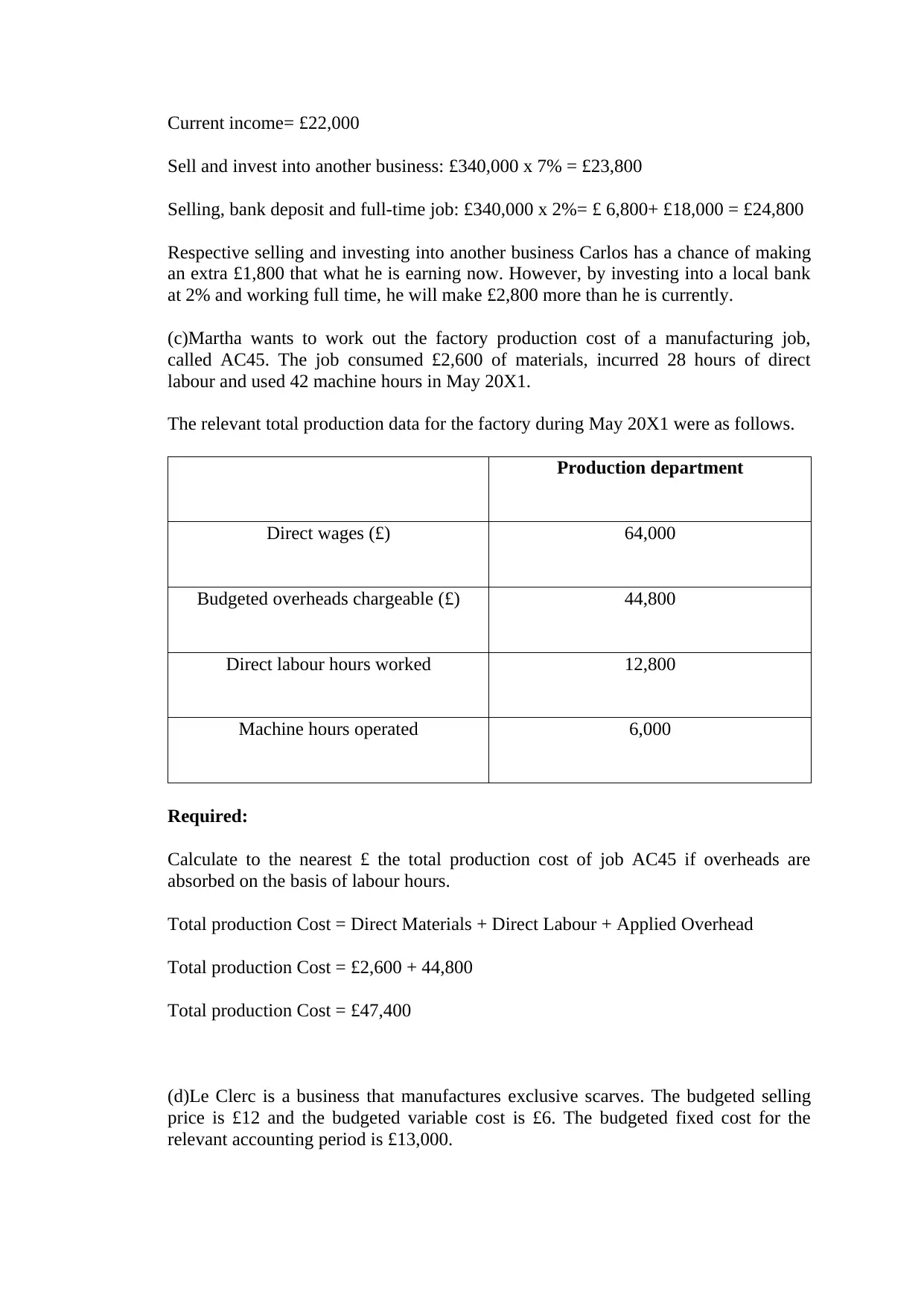
Current income= £22,000
Sell and invest into another business: £340,000 x 7% = £23,800
Selling, bank deposit and full-time job: £340,000 x 2%= £ 6,800+ £18,000 = £24,800
Respective selling and investing into another business Carlos has a chance of making
an extra £1,800 that what he is earning now. However, by investing into a local bank
at 2% and working full time, he will make £2,800 more than he is currently.
(c)Martha wants to work out the factory production cost of a manufacturing job,
called AC45. The job consumed £2,600 of materials, incurred 28 hours of direct
labour and used 42 machine hours in May 20X1.
The relevant total production data for the factory during May 20X1 were as follows.
Production department
Direct wages (£) 64,000
Budgeted overheads chargeable (£) 44,800
Direct labour hours worked 12,800
Machine hours operated 6,000
Required:
Calculate to the nearest £ the total production cost of job AC45 if overheads are
absorbed on the basis of labour hours.
Total production Cost = Direct Materials + Direct Labour + Applied Overhead
Total production Cost = £2,600 + 44,800
Total production Cost = £47,400
(d)Le Clerc is a business that manufactures exclusive scarves. The budgeted selling
price is £12 and the budgeted variable cost is £6. The budgeted fixed cost for the
relevant accounting period is £13,000.
Sell and invest into another business: £340,000 x 7% = £23,800
Selling, bank deposit and full-time job: £340,000 x 2%= £ 6,800+ £18,000 = £24,800
Respective selling and investing into another business Carlos has a chance of making
an extra £1,800 that what he is earning now. However, by investing into a local bank
at 2% and working full time, he will make £2,800 more than he is currently.
(c)Martha wants to work out the factory production cost of a manufacturing job,
called AC45. The job consumed £2,600 of materials, incurred 28 hours of direct
labour and used 42 machine hours in May 20X1.
The relevant total production data for the factory during May 20X1 were as follows.
Production department
Direct wages (£) 64,000
Budgeted overheads chargeable (£) 44,800
Direct labour hours worked 12,800
Machine hours operated 6,000
Required:
Calculate to the nearest £ the total production cost of job AC45 if overheads are
absorbed on the basis of labour hours.
Total production Cost = Direct Materials + Direct Labour + Applied Overhead
Total production Cost = £2,600 + 44,800
Total production Cost = £47,400
(d)Le Clerc is a business that manufactures exclusive scarves. The budgeted selling
price is £12 and the budgeted variable cost is £6. The budgeted fixed cost for the
relevant accounting period is £13,000.
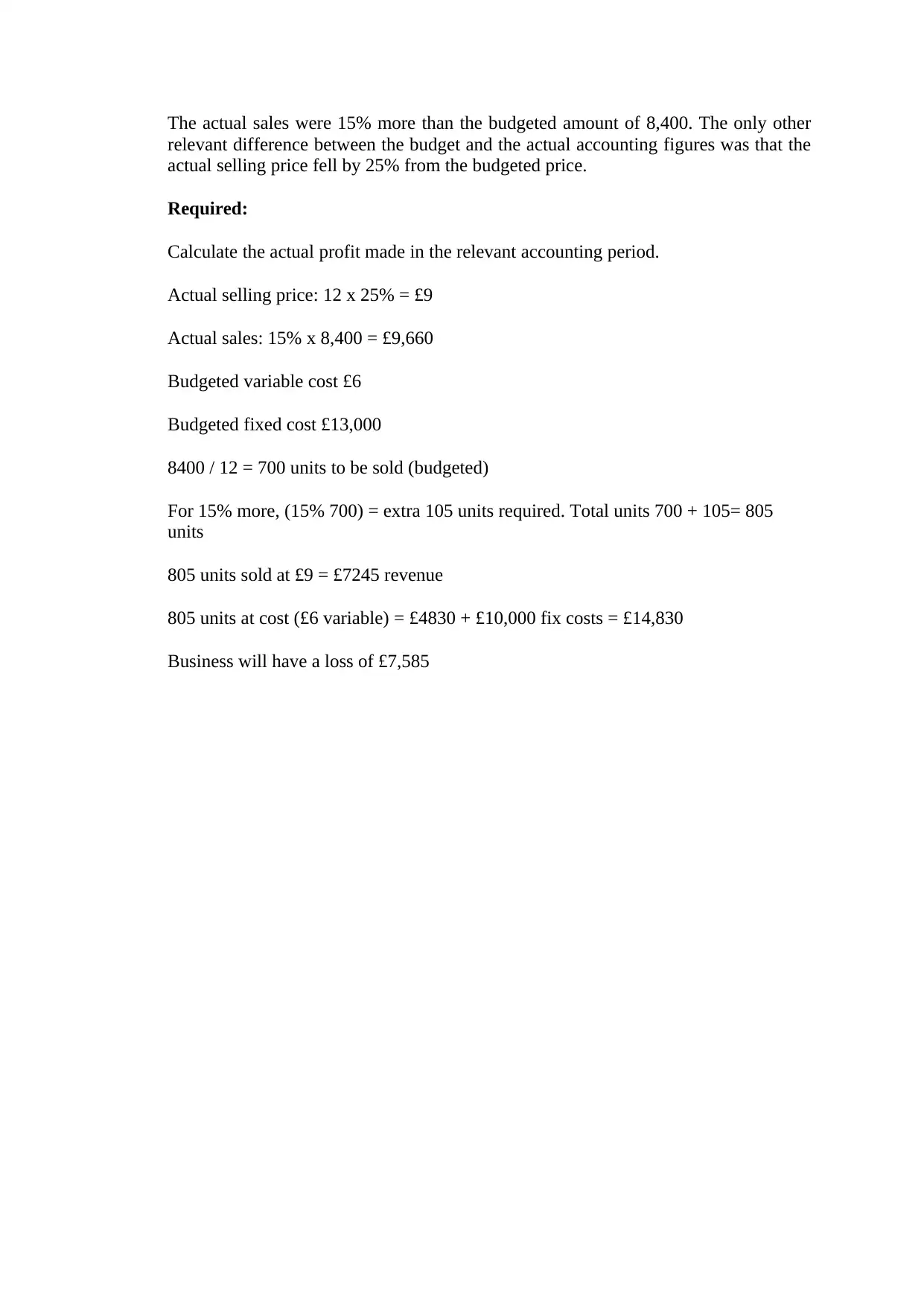
The actual sales were 15% more than the budgeted amount of 8,400. The only other
relevant difference between the budget and the actual accounting figures was that the
actual selling price fell by 25% from the budgeted price.
Required:
Calculate the actual profit made in the relevant accounting period.
Actual selling price: 12 x 25% = £9
Actual sales: 15% x 8,400 = £9,660
Budgeted variable cost £6
Budgeted fixed cost £13,000
8400 / 12 = 700 units to be sold (budgeted)
For 15% more, (15% 700) = extra 105 units required. Total units 700 + 105= 805
units
805 units sold at £9 = £7245 revenue
805 units at cost (£6 variable) = £4830 + £10,000 fix costs = £14,830
Business will have a loss of £7,585
relevant difference between the budget and the actual accounting figures was that the
actual selling price fell by 25% from the budgeted price.
Required:
Calculate the actual profit made in the relevant accounting period.
Actual selling price: 12 x 25% = £9
Actual sales: 15% x 8,400 = £9,660
Budgeted variable cost £6
Budgeted fixed cost £13,000
8400 / 12 = 700 units to be sold (budgeted)
For 15% more, (15% 700) = extra 105 units required. Total units 700 + 105= 805
units
805 units sold at £9 = £7245 revenue
805 units at cost (£6 variable) = £4830 + £10,000 fix costs = £14,830
Business will have a loss of £7,585
1 out of 10
Your All-in-One AI-Powered Toolkit for Academic Success.
+13062052269
info@desklib.com
Available 24*7 on WhatsApp / Email
![[object Object]](/_next/static/media/star-bottom.7253800d.svg)
Unlock your academic potential
© 2024 | Zucol Services PVT LTD | All rights reserved.
